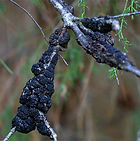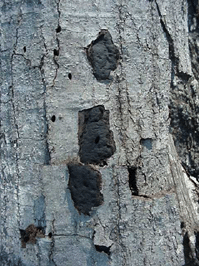
MEMPHIS: 901-854-3970
Serving Memphis, Nashville, Chattanooga and the Surrounding Areas
Timberline Tree & Lawn Care, INC. is proud to be a division of Bartlett Tree Experts, and our staff now has the backing of an international tree care company and research laboratory to help continue providing excellent tree service throughout Lawrence, Shelby, McCraken, Fayette, Dyer, and Mississippi counties. View a complete list of professional tree services offered by Bartlett.

Tree Diseases

Anthracnose
Anthracnose is a group of diseases that cause dark, sunken lesions on leaves, stems, flowers, and fruits. Anthracnose infects many deciduous and evergreen trees and shrubs and in some regions also infects fruits, vegetables, and turfgrass.

Apple Scab
Apple and pear scab are two different diseases that look very similar and are controlled in similar manners in home gardens and landscapes. Both cause spotting and scabbing of fruit, especially during wet springs but different fungi cause them.

Armillaria Rootrot

Black Knot
Armillaria root disease is found throughout temperate and tropical regions of the world. In the continental United States, the disease has been reported in nearly every State. Hosts include hundreds of species of trees, shrubs, vines, and forbs growing in forests, along roadsides, and in cultivated areas.
Black knot is a common and often serious disease of plum and prune trees in New York. Once established, the disease becomes progressively more severe each year unless control measures are taken. Infected limbs and twigs lose vigor and may eventually die, and commercial plantings in which the disease becomes widespread are seldom economically viable to maintain. Black knot is occasionally found on cherries, peaches, and apricots but is seldom a problem on these trees.

Black Spot

Dutch Elm Disease
Black spot causes black spots to develop on the upper surface of leaves and succulent stems. The spots have feathery or fiber-like margins and no powdery growth on the undersides of leaves. Small black fruiting bodies are often present in spots on upper sides of leaves. Yellow areas develop around the spots. Leaves may drop.
Dutch elm disease is a fungal disease that will infect all native elm trees; however, the disease does not always kill the tree. The success and rate of movement within the tree depends on tree size, time and location of infection in the tree, climatic conditions, and the defensive response of the tree

Entosphorium Leafspot

Fireblight
Tiny reddish spots, sometimes surrounded by a yellow halo, appear on the leaves of infected plants, usually on older growth. These spots darken and enlarge as the leaves mature. Spore-forming bodies eventually appear in the center of the spots
Fire blight, caused by the bacterium Erwinia amylovora, is a common and frequently destructive disease of pome fruit trees and related plants. Pear and quince are extremely susceptible. Apple, crabapple, and firethorns also are frequently damaged. Fire blight is less common on hawthorn, Spiraea, Cotoneaster, toyon, juneberry or serviceberry, loquat, mountain ash, and other related plants. The disease can destroy limbs and even entire shrubs or trees.

Fusarium Blight

Hypoxlyn Canker
Fusarium blight first appears as small, circular, grayish green areas, ranging from a few inches up to a foot in diameter. Some plants in the center of the circles may survive, giving them a frog eye or donut appearance. The crown or basal area of the dead stems is affected with a reddish rot and is hard and tough. At times, a pink layer of the fungus can be seen near the soil line. The dead foliage appears bleached. The fungus survives as mycelia in plant debris and plants killed by previous infections, or as thick walled resting spores in the thatch and soil.

Nectria Canker
Nectria canker initially appears as a slightly sunken, elongated lesion. The surface of the outer bark is often discolored and may be open or covered with bark. Attempts by the tree to contain the infection result in the formation of a callus ridge during the growing season. If the tree is not successful, the fungus will reinfect healthy wood beyond the callus ridge the following year. As a result, perennial cankers develop a target-like appearance, due to the alternation of fungal growth and the production of callus tissue by the tree. Eventually, branch dieback or death of the tree may occur if branches or the trunk are girdled by the fungus. Cankered trees are vulnerable to windthrow, commonly breaking at the canker site.

Powdery Mildew
Powdery mildew is a common disease on many types of plants. There are many different species of powdery mildew fungi and each species only attacks specific plants. A wide variety of vegetable crops are affected by powdery mildews.
Powdery mildews generally do not require moist conditions to establish and grow, and normally do well under warm conditions; thus they are more prevalent than many other leaf-infecting diseases under California’s dry summer conditions.
Hypoxylon canker is a fungus that causes cankers and death of oak and other hardwood trees. The disease is common all across the southern United States. Relatively healthy trees are not invaded by the fungus, but the hypoxylon fungus will readily infect the sapwood of a tree that has been damaged, stressed, or weakened. Natural and man-caused factors that can weaken a tree include defoliation by insects or leaf fungi, saturated soil, fill dirt, soil compaction, excavation in the root zone of the tree, removal of top soil under the tree, disease, herbicide injury, drought, heat, nutrient deficiencies, competition or overcrowding, and other factors. The hypoxylon fungus is considered a weak pathogen in that it is not aggressive enough to invade healthy trees. In addition to the hypoxylon fungus, weakened and stressed trees may become susceptible to a host of other insect and disease pests.

Phloem Necrosis
Phloem necrosis of American elm is a disease of unknown origin of many years standing, which is now widespread in the region of the central and lower Ohio River watershed. It extends to northern Mississippi, eastern Oklahoma, Kansas, Nebraska, and is generally distributed throughout Missouri. It damages the tissues that conduct food to all parts of the tree, and it causes wilting and death. Both forest and shade trees are affected, and trees of all ages and all degrees of vigor are susceptible. Trees may be infected for six months to one or more years before symptoms appear. The majority of infected trees usually die from 1 to 1-1/2 years, although some may die in three to four weeks and others may survive for two or more years. Since all infected trees die eventually, this is a serious disease of elms.

Phomposis Blight
For most people, the first symptom noticed in the spring is the die-back of the new shoot growth. The new growth changes from light yellow green to red brown to ash gray as it dies from this fungal disease. Phomopsis juniperovora only kills the new growth - if more than just the new growth is killed, other fungal diseases or environmental injury is involved.

Rust

Seridium Canker
The rusts are a group of fungal diseases affecting the aerial parts of plants. Leaves are affected most commonly, but rust can also be found occasionally on stems and even flowers and fruit.
The spore pustules produced by rusts vary in colour, according to the rust species and the type of spore that it is producing. Some rusts have complex life-cycles, involving two different host plants and up to five types of spore.
Seiridium canker, also known as Cypress canker, was first reported in California in the late 1920s and has since spread throughout North America and into Florida wherever Cupressaceae (cypress family) grow. The disease has raised some concern in Florida due to the damage and mortality observed on Leyland cypress. Leyland cypress can be killed or severely disfigured by the disease. Disease management considerations and tree replacements with resistance to Seiridium canker are recommended.

Shot hole Fungus

Shoestring Root Rot
Small reddish spots will form on new leaves as well as the shoots, slowly expanding the center of the spots turn brownish. The center of the spots on the newer leaves will often fall out, hence the term “Shot Hole Fungus”
The crown of the diseased tree will begin to turn a brownish yellow and thin out. You may find dead tissue on the ground as the decay progresses into the tree. The wood that is decaying may appear to be water soaked with a greyish tone to it. Next the wood is so brittle it becomes stringy and spongey to the touch.

Sooty Mold

Tar Spot
Sooty molds don’t infect plants but grow on surfaces where honeydew deposits accumulate. However, they can indirectly hurt the plant by coating the leaves so thickly that sunlight will not pass through. Without the leaves getting enough sunlight they can’t carry out photosynthesis.
Tar spot is common and easy to point on the leaf, it is a leaf fungus. While tar spot favors Silver Maple trees, and will also go for Boxelders, and Willow trees.

Verticlium Wilt
Verticillium wilt is considered a serious disease, due to the fact that it can spread internally. Naturally forested areas are seldom affected by Verticillium wilt. Verticillium is easily confused with other diseases and abiotic factors. Such as herbicide and mechanical damage as they cause the same symptoms.

Volutella Canker
At first, Volutella blight causes tan spots with brown rings on the leaves. Also infecting the stem, Volutella disrupts water and mineral transport. The plant is then suffocated from that point and up, since it cannot deliver any nutrients.

Xanthomonas
Xanthomas causes bacterial spots and blights of leaves, stems, and fruits on a wide variety of plant species. Citrus canker, caused by Xanthomas, is an economically important disease of many citrus species.

